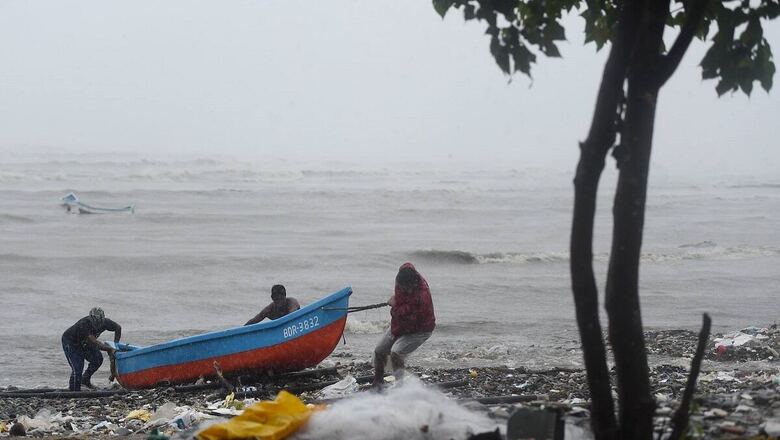
views
Kolkata: Less than a week after severe cyclonic storm ‘Tauktae’ wreaked havoc in some of the Western states, including Maharashtra and Gujarat, the India Meteorological Department has now warned of another depression building over the North Andaman Sea in the Bay of Bengal. The depression is likely to intensify into a powerful cyclone.
As per the World Meteorological Organisation (WMO) norms, once the depression turns into a cyclone, it will be known as ‘Yaas’. As per prediction, it will start gaining its ferocity in the Bay of Bengal from May 22-24 onwards and will hit the eastern coasts of West Bengal and Odisha between May 26-27.
Like other peculiar names of previous Cyclones and their origins, ‘Yaas’ has also become one of the most searched words on the internet. The word ‘Yaas’ means despair or desperation in Arabic.
Multiple organisations like United Nations Economic and Social Commission for Asia (UNESCA), World Meteorological Organisation (WMO), All the Regional Specialised Meteorological Centres (RSMC) including IMD and Cyclone Warning Centres from across the globe collectively decide the names of cyclones in the world.
The UNESCA and WMO comprise of Oman, India, Bangladesh, Sri Lanka, Myanmar, Thailand and Pakistan, and United Arab Emirates, Yemen, Qatar, Iran and Saudi Arabia respectively.
The global meteorological bodies keep interesting names of Cyclones for its long remembrance and for smooth coordination among various disaster management groups during rescue and relief operations. Also, interesting names help various disaster management groups to clear confusion while sending alerts.
After cyclone ‘Yaas’, there are many more cyclones which may hit various places across the globe in coming months. The first one which is likely to hit after ‘Yaas’ is ‘Gulab’, which was named by Pakistan. After ‘Gulab’, ‘Shaheen’ (named by Qatar), ‘Jawad’ (named by Saudi Arabia), ‘Asani (name given by Sri Lanka), ‘Sitrang’ (named by Thailand), ‘Mandous’ (by UAE) and ‘Mocha’ named by Yemen) may hit various coastal areas across the globe in coming months.
Speaking to News18, Sanjib Banerjee, the Deputy Director General of the Indian Meteorological Department at Alipore in Kolkata, said, “We are monitoring the situation and it is too early to forecast the exact trajectory and potential landfall area of ‘Yaas’. The low pressure system is likely to form on May 22. Then only we can track its exact track and landfall area with more accuracy.”
He said, “As of now, it is likely to move north-westwards and it is likely to hit the West Bengal-Odisha coasts on May 26.”
The statement issued by IMD reads, “A low pressure area is very likely to form over North Andaman sea and adjoining East-Central of Baby of Bengal on May 22 with moderate to high possibility of formation of ‘Cyclogenesis’ (development of depression) on May 23. The system is very likely to intensify into a cyclonic storm by May 24. It is very likely to move northwestwards and reach near Odisha and West Bengal coasts around May 26 in the morning.”
On the evening of May 25, the coastal districts of Odisha and West Bengal are likely to witness rainfalls, gusty winds with a speed of 60 kmph.
Meanwhile, West Bengal Chief Minister Mamata Banerjee has reviewed preparedness to handle the natural calamity with the district officials at East Midnapore and adjoining areas.
Disaster Management Groups, District administrative officials, police, fire department, municipal officers, health care workers, and heads of various panchayats were asked to stay alert. Work on to set up relief camps are going on for the people living in the possible landfall zone.
Sources said, the chief minister has decided to station at the Cyclone ‘Yaas’ Control Room at the state secretariat ‘Nabanna’ from May 25 to May 26.
In the past, West Bengal had witnessed many Cyclones and one of the early officially recorded calamities as per the ‘West Bengal Disaster Management and Civil Defence Department’ happened on October 7 in 1737 and it continued till October 12. Then the super cyclone crossed the West Bengal coast over Sunderbans and claimed nearly 3 lakhs lives.
The next one which hit the Coastal regions of West Bengal was on October 2, 1864 and the mayhem continued till October 5. Then, it crossed the coast near Contai in East Midnapore. More than 50,000 people were killed mostly due to drowning and 30,000 due to outbreak as a result of inundation.
On October 14, 1942 another severe Cyclonic Storm crossed over the West Bengal coast near Contai in East Midnapore. The Cyclone continued till October 16, 1942. Then, more than 19,000 people were killed and nearly 60,000 cattle heads died.
On May 25-27, 2009, severe cyclonic storm ‘Aila’ crossed close to the east of Sagar Island in South 24-Parganas which killed 137 people. The areas and districts affected by the cyclone include East Midnapore, Howrah, Hooghly, Burdwan, South 24 Parganas and Kolkata.
On May 20, 2020, Cyclone Amphan hit West Bengal and it left an irreparable damage in the ecological fragile Sundarbans region. It claimed 72 lives and left thousands homeless.
With the power of three hurricanes combined and believed to Bengal’s fiercest Cyclone in decades – unlike cyclones ‘Aila’ and ‘Bulbul’ which claimed more than 300 lives in Bengal and in Bangladesh on May 2009 and November 2019 respectively – ‘Amphan’ had its monstrous impact because at the time of landfall there was high tide in the river and the mud embankment has failed to prevent seawater from entering the agricultural land.
Read all the Latest News, Breaking News and Coronavirus News here. Follow us on Facebook, Twitter and Telegram.



















Comments
0 comment